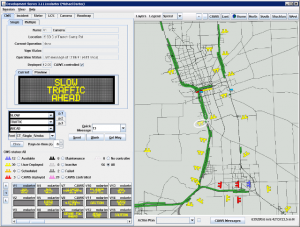
Multi-State Open Advanced Traffic Management System Lowers Costs
Link to pdf here.
See IRIS Wiki
| Outcome | Deployment of Open-source Advanced Traffic Management System software and commodity hardware components. Delivery: May 2012 |
| Benefit | Dramatically reduce lifecycle costs of ATMS ownership. Potential savings exceed several million dollars per year. |
AHMCT researchers are demonstrating the application of an Advanced Traffic Management System (ATMS) based on open standards, open software, and commodity computer hardware. This approach can greatly reduce ATMS deployment and maintenance costs, freeing funds for additional ATMS deployment. This approach also benefits public safety and mobility by enabling ATMS installation in remaining Caltrans districts at relatively little incremental cost.
Why We Are Pursuing This Research
The goal of this research was continued exploration of open-source ATMS (Advanced Transportation Management System) software solutions that showed significant potential for adaptation and deployment within the California Department of Transportation (Caltrans). In so doing, this project would demonstrate the installation of such a solution at a location where ATMS had never before been installed. Such a demonstration could yield some of the same benefits the Department has come to rely on with ATMS installations. These benefits include increased public safety, transportation efficiency, sustainability, and fostering transportation management innovation. This was especially true for Caltrans districts that did not need many of the advanced features used by the large metropolitan regions of California. The demonstration location chosen was District 10 in Stockton, California.
What We Are Doing
The researchers at the AHMCT Research Center at UC Davis used innovative, newly available, free, open-source ATMS software called IRIS (the Intelligent Roadway Information System) as the basis for creating an enhanced transportation management system.
IRIS was originally developed by the Minnesota Department of Transportation (Mn/DOT), and made freely available in 2007. Caltrans is the first transportation agency to embrace IRIS and make use of its innovative, collaborative, shared development model known as open-source. Working with Caltrans and Mn/DOT, the researchers collaboratively developed enhancements, and extended IRIS to be compatible with the Caltrans District 10 infrastructure and field devices as well as adapting it to match the district’s specific nuances and operational aspects. The enhanced IRIS system was integrated with existing Caltrans hardware and software systems. Enhancements were contributed back to Mn/DOT for use by other public and private agencies. The researchers modified IRIS to assume the functions of middleware and Automated Warning System for District 10. Extensive user acceptance and operational testing were performed, leading to deployment in Caltrans District 10. Pilot testing was performed in Districts 1, 2, and 5.
What Can Be Concluded From This Research
Caltrans is the first transportation agency to embrace IRIS and make use of its open-source feature. Study results are promising. The IRIS open-source ATMS software dramatically lowers costs compared with proprietary systems. It is estimated that the initial and ongoing system costs would be 72% lower than a proprietary system.
The system provides significant capabilities, improved safety, lower personnel maintenance needs, and higher reliability. For example, IRIS provides changeable message sign libraries and fonts, as well as system logging, error checking, and configuration flexibility.
The collaborative IRIS system has the potential of increasing the rate of transportation technology innovation for Caltrans. Access to the IRIS software source code is not restricted by legal agreements, and the source is available for other public and private transportation agencies to use and modify. This is expected to increase the rate of innovation for Caltrans by enabling direct access and collaboration by Caltrans staff, researchers, students, and innovators.
What Do The Researchers Recommend
First, the researchers recommend continued use of IRIS in rural and semi-rural districts, with deployment to Districts 1, 2, and 5. The rate of technological change in many industries, including transportation, is high. The researchers recommend using open-source software to facilitate rapid innovation at a much lower cost than possible with proprietary systems. This model can save taxpayers money, while increasing transparency and improving the level of service transportation agencies are able to provide. This approach also facilitates knowledge management and transfer for agencies and researchers.
Further research into collaborative methods of improving public safety—such as Active Traffic Management (ATM) capabilities, guided lane use, variable speed limit signs, and alternative route usage, among others—would further enhance public safety, efficiency, and sustainability.
Implementation Strategies
The enhanced IRIS system is in the deployment stage and is being actively used in Caltrans District 10. A Feasibility Study Report (FSR) was completed for full deployment of IRIS in Districts 1, 2, and 5. AHMCT is continuing maintenance and enhancement of IRIS for Districts 1, 2, 5, and 10.
The open-source software model creates implementation opportunities for organizations such as State Departments of Transportation, municipalities, universities, and consultants. Efficient development, implementation and funding can be shared across agencies, which is difficult or impossible with closed proprietary systems.
For Additional Information
| Stan Slavin Caltrans Technical Advisory Group Leader |
stan_slavin (at) dot.ca.gov | (916) 653-3068 |
| Fred Yazdan Caltrans Project Manager |
fred_yazdan (at) dot.ca.gov | (949) 936-3462 |
| Ty A. Lasky Principal Investigator |
talasky (at) ucdavis.edu | (530) 752-6366 |
| Bahram Ravani Co-Principal Investigator |
bravani (at) ucdavis.edu | (530) 754-6130 |
This document is disseminated in the interest of information exchange. The contents do not necessarily reflect the official views or policies of the AHMCT Research Center, the University of California, the State of California, or the Federal Highway Administration. This document does not constitute a standard, specification, regulation, or imply endorsement of the conclusions or recommendations.
(rev. April 2012)
